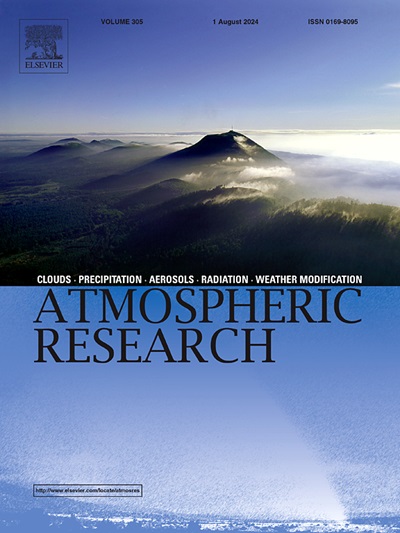全球变暗和变亮的主要驱动因素是什么?
IF 4.5
2区 地球科学
Q1 METEOROLOGY & ATMOSPHERIC SCIENCES
引用次数: 0
摘要
全球变暗和变亮(GDB)现象在地球气候中起着重要作用,云和气溶胶是主要的驱动因素。本研究通过量化1984-2018年期间云、气溶胶、水汽和臭氧变化对地表太阳辐射(SSR)变化的贡献,探讨了GDB的成因。为此,利用现代和改进的云和气溶胶数据集,利用FORTH-RTM(研究与技术基金会- hellas辐射传输模型)按月和0.5°x0.625°空间分辨率进行辐射传输计算。对高质量地面测量的验证证实了RTM的可靠性。结果表明,从1984年到2018年,全球平均变亮为0.88 Wm−2decade−1,陆地(2.57 Wm−2decade−1)强于海洋(0.19 Wm−2decade−1)。在全球范围内,云的变化(特别是中层云量(CA)和高层云光学厚度(COT))是GDB的主要驱动因素。气溶胶光学深度(AOD)变化在欧洲、印度和华东等特定的人为活动强烈的陆地区域贡献显著。在80年代和90年代,AOD的变化是GDB的主要驱动因素,随后在2000年代,高层云光学厚度对GDB的贡献最大,其次是AOD的变化,最后在2010年代,云和AOD的贡献相当。在陆地上,AOD对GDB的贡献与云相当,而气溶胶的不对称参数(AP)、单散射反照率(SSA)、水汽和臭氧的贡献很小或不显著。本文章由计算机程序翻译,如有差异,请以英文原文为准。
Which are the main drivers of global dimming and brightening?
The Global Dimming and Brightening (GDB) phenomenon plays an important role in the Earth's climate, with clouds and aerosols being the major drivers. This study investigates GDB causes by quantifying the contributions of changes in clouds, aerosols, water vapor and ozone to the surface solar radiation (SSR) changes during 1984–2018. To this aim, radiative transfer calculations were performed by the FORTH-RTM (Foundation for Research and Technology-Hellas Radiative Transfer Model) on a monthly basis and 0.5°x0.625° spatial resolution using modern and improved datasets for clouds and aerosols. Validation against high-quality ground measurements confirmed RTM's reliability. Results show a global mean brightening of 0.88 Wm−2decade−1 from 1984 to 2018, stronger over land (2.57 Wm−2decade−1) than oceans (0.19 Wm−2decade−1). Globally, changes in clouds (especially middle-level cloud amount (CA) and high-level cloud optical thickness (COT)) were the main GDB drivers. However, the contribution of aerosol optical depth (AOD) changes was remarkable over specific land areas with strong anthropogenic activity, such as Europe, India and East China. In the 80's and 90's changes in AOD were the main GDB driver, subsequently in the 2000s high-level cloud optical thickness contributed the most to GDB followed by the AOD changes, while finally in the 2010s both clouds and AOD had comparable contributions. Over land, AOD had a comparable contribution to GDB with that of clouds whereas the contribution of aerosols' asymmetry parameter (AP) and single scattering albedo (SSA), water vapor and ozone was quite small or insignificant.
求助全文
通过发布文献求助,成功后即可免费获取论文全文。
去求助
来源期刊

Atmospheric Research
地学-气象与大气科学
CiteScore
9.40
自引率
10.90%
发文量
460
审稿时长
47 days
期刊介绍:
The journal publishes scientific papers (research papers, review articles, letters and notes) dealing with the part of the atmosphere where meteorological events occur. Attention is given to all processes extending from the earth surface to the tropopause, but special emphasis continues to be devoted to the physics of clouds, mesoscale meteorology and air pollution, i.e. atmospheric aerosols; microphysical processes; cloud dynamics and thermodynamics; numerical simulation, climatology, climate change and weather modification.
 求助内容:
求助内容: 应助结果提醒方式:
应助结果提醒方式:


